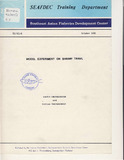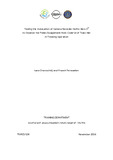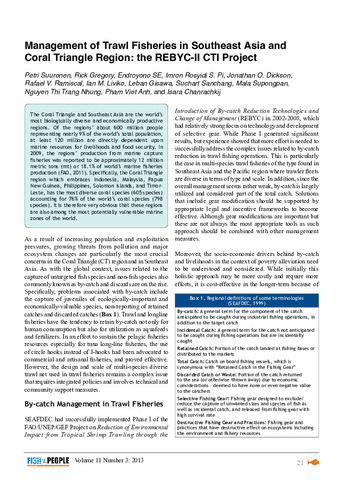Model Experiment on Shrimp Trawl
Share
Abstract
Trawls are recognized as a fishing gear that has a high catching efficiency and plays an important role in the fisheries of the world. However, trawls are also seen as a type of gear that accelerates the destruction of natural resources.
A shrimp trawl that is designed primarily to catch shrimp. However, the shrimp trawl catch not only shrimp but also small fish, juveniles and other marine animals. Approximately 70 percent of the catch of a shrimp trawl consists of trash fish . It should be not that the so-called fish include juveniles and fry of several economically important species.
It appears that trash fish are an unwanted catch for shrimp trawlers because of the low return. The shrimp will be picked out from the catch and the rest will sometimes be thrown back. It is a mistake to ignore the effects this practice will have on the natural resources, particularly since some of these fish would become profitable if fishermen only waited to catch them when they are of adult size.
A trawl net with a window is one of the devices to catch only shrimp and thus avoid the destruction of natural resources by allowing small fish or juveniles to escape. This device has been adopted in many parts of the world.
An experiment was carried out to establish the effect of the window in a full-scale net. For the compete experiment, a model was used because of the difficulty of studying the physical aspects underwater in a full-scale experiment.
The model experiment was carried out with two purposes:
1. To study the resistance of net and height of net month as affected by the window of the net; and
2. To compare the resistance of net and height of net mouth of two-seam and four-seam nets.
This paper presents the results of the model experiment on shrimp trawl and the method used, for those who are interested in the operation of this gear. It also describes how to make a model net.
Subject
Collections
Related items
Showing items related by title, author, creator and subject.
-
Economic efficiency of trawl fisheries: A case of trawl fisheries in Nha Trang, Vietnam
Van Hao, Tran; Flaaten, Ola; Khanh Ngoc, Quach Thi (Secretariat, Southeast Asian Fisheries Development Center, 2012) -
Testing the Installation of Camera Recorder GoPro Hero 3 to Observe the Fishes Escapement from Codend of Trawl Net in Trawling Operation
Chanrachkij, Isara; Petrasatien, Prasert (Training Department, Southeast Asian Fisheries Development Center, 2016)The Testing the Installation of Camera Recorder GoPro Hero 3® to observe the Fishes Escapement from Codend of Trawl Net in Trawling Operation was conducted in with Fisheries Research Vessel Pramong No.16 of Eastern Marine ... -
Management of trawl fisheries in Southeast Asia and coral triangle region: the REBYC-II CTI project
Suuronen, Petri; Gregory, Rick; SE, Endroyono; Rosyidi S. Pi, Imron; Dickson, Jonathan O.; Ramiscal, Rafael V.; Liviko, Ian M.; Gisawa, Leban; Sanchang, Suchart; Supongpan, Mala; Thi Trang Nhung, Nguyen; Viet Anh, Pham; Chanrachkij, Isara (Secretariat, Southeast Asian Fisheries Development Center, 2013)





